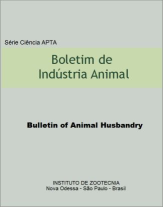Effect of mineral supplementation on live weight of nelore heifers
Palavras-chave:
beef cattle, consumption, growing animalsResumo
Brazilian soils generally suffer from mineral deficiency, so that pasture alone cannot supply the mineral requirements of beef cattle, mainly during the animals€™ growth phase, after weaning, when there is a high need for mineral salt supplementation. The objective of this study was to evaluate the effect of two types of mineral supplements on the weight of Nellore heifers, from weaning until 22 months of age. The research project was developed at the APTA Beef Cattle Center of the Institute of Zootechnics. Eighty-four Nellore heifers from the Traditional and Selected herds belonging to the Animal Science Institute, Sertãozinho, SP, were used, with average age of eight months at the beginning of the experiment in May 2016. Half of the heifers were kept in pastures receiving a commercial mineral supplement (TEST), while another 46 heifers were kept in pastures receiving blocks of mineral supplement with molasses from Caltech-Crystalyx (CRY), an English company. Both supplements were formulated for the dry season or wet season. The mineral supplement intake of each group was recorded weekly, by weighing the total product offered and left over. The animals were weighed every 28 days and afterwards the animals switched from one pasture to the other. The intake of the supplement varied greatly during the experiment. The animals that received supplementation in the form of CRY blocks presented average consumption levels of 189; 214 and 225 g animal-1 day-1 , while the consumption levels of the TEST group were 100; 67 and 87 g animal-1, day-1, from June to November 2016; from November 2016 to April 2017 and from May to August 2017, respectively. The CRY group had significantly higher weights (P<0.050) in the months of January, February, April and July 2017, when they 14, 15, 17 and 20 months old. In the other months, there was no difference (P>0.05) between the supplements. The weights found for CRY heifers were 249.0 ± 4.61; 264.9 ± 5.04; 298.5 ± 5.25; 358.54 ± 6.03 kg animal-1, and for TEST heifers were 233.84 ± 4.65; 251.56 ± 5.07; 282.42 ± 5.28 and 339.32 ± 5.98 kg animal-1, for the ages of 14, 15, 17 and 20 months, respectively. In conclusion, the CRY group obtained better results regarding weight gain and maintenance than the animals in the TEST group.
Downloads
Downloads
Publicado
Edição
Seção
Licença
Os autores não serão remunerados pela publicação de trabalhos, pois devem abrir mão de seus direitos autorais em favor deste periódico. Por outro lado, os autores ficam autorizados a publicar seus artigos, simultaneamente, em repositórios da instituição de sua origem, desde que citada a fonte da publicação original seja Boletim de Indústria Animal. A revista se reserva o direito de efetuar, nos originais, alterações de ordem normativa, ortográfica e gramatical, com vistas a manter o padrão culto da língua e a credibilidade do veículo. Respeitará, no entanto, o estilo de escrever dos autores. Alterações, correções ou sugestões de ordem conceitual serão encaminhadas aos autores, quando necessário. Nesses casos, os artigos, depois de adequados, deverão ser submetidos a nova apreciação. As opiniões emitidas pelos autores dos artigos são de sua exclusiva responsabilidade. Todo o conteúdo deste periódico, exceto onde está identificado, está licenciado sob a Licença Creative Commons Attribution (CC-BY-NC). A condição BY implica que os licenciados podem copiar, distribuir, exibir e executar a obra e fazer trabalhos derivados com base em que só se dão o autor ou licenciante os créditos na forma especificada por estes. A cláusula NC significa que os licenciados podem copiar, distribuir, exibir e executar a obra e fazer trabalhos derivados com base apenas para fins não comerciais.













